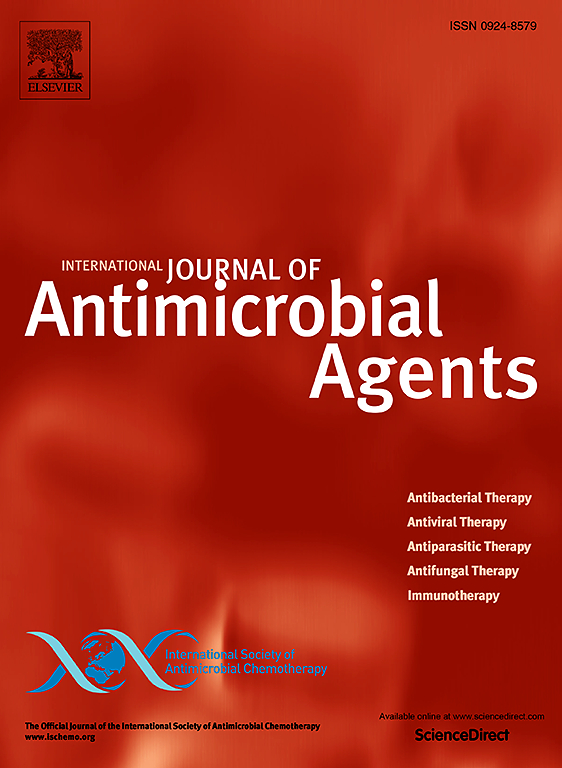体外膜氧合对危重患者粘菌素药代动力学的影响:COL-ECMO2022试验结果
IF 4.6
2区 医学
Q1 INFECTIOUS DISEASES
International Journal of Antimicrobial Agents
Pub Date : 2025-07-29
DOI:10.1016/j.ijantimicag.2025.107582
引用次数: 0
摘要
简介:粘菌素被认为是治疗多重耐药革兰氏阴性菌引起的感染的最后手段抗生素,特别是对危重患者。然而,它对体外膜氧合(ECMO)回路的干扰可能影响治疗目标的实现。COL-ECMO2022研究旨在验证粘菌素及其前药粘菌时间磺磺酸盐(CMS)对ECMO的干扰。方法:一项前瞻性药代动力学IV期研究纳入了肠外粘菌素作为标准医疗护理一部分的危重成人。对每位患者最多监测三个给药间隔。采用高效液相色谱-质谱法测定CMS和粘菌素浓度。比较ECMO和非ECMO患者的平均稳态粘菌素浓度(CAVG,SS)、群体药代动力学模型(ECMO作为协变量)和线性混合效应模型(LMEM)。结果:对18例患者和40例监测给药间隔进行了分析。7例ECMO患者的中位CAVG、SS [4.3 (3.5-6.3) mg/L]比11例非ECMO患者的中位CAVG、SS [5.2 (4.2-11.5) mg/L]低18%; = 0.551页)。在种群PK模型中,ECMO不是任何药代动力学参数的显著协变量。尽管LMEM在ECMO回路上对CMS有显著的吸附作用,但粘菌素浓度并未受到显著影响。结论:两组间粘菌素血药浓度无显著差异;因此,ECMO患者无需调整CMS剂量。本文章由计算机程序翻译,如有差异,请以英文原文为准。
Changes of colistin pharmacokinetics in critically ill patients due to the extracorporeal membrane oxygenation: Results of the COL-ECMO2022 trial
Introduction
Colistin is recognized as the last-resort antibiotic for treating infections caused by multidrug-resistant Gram-negative bacteria, especially in critically ill patients. However, its interference with the extracorporeal membrane oxygenation (ECMO) circuit may affect the achievement of therapeutic targets. The COL-ECMO2022 study aimed to verify the interference of colistin and its prodrug colistimethanesulphonate (CMS) with ECMO.
Methods
A prospective pharmacokinetic phase IV study included critically ill adults in whom the parenteral colistin was part of standard medical care. A maximum of three dosing intervals were monitored for each patient. CMS and colistin concentrations were measured by HPLC-MS. ECMO and non-ECMO patients were compared by average steady-state colistin concentration (CAVG,SS), population pharmacokinetic model (ECMO as a covariate), and linear mixed-effect model (LMEM).
Results
Eighteen patients and 40 monitored dosing intervals were analyzed. Median CAVG,SS was non-significantly lower in 7 patients on ECMO (4.3 [3.5–6.3] mg/L) than in 11 non-ECMO patients (5.2 [4.2–11.5] mg/L) (by 18%; P = 0.551). ECMO was not a significant covariate for any pharmacokinetic parameter in the population PK model. Although LMEM proved significant adsorption of CMS on the ECMO circuit, colistin concentrations were not significantly influenced.
Conclusion
No significant differences in colistin plasma concentrations were detected; therefore, CMS dosage adjustment is unnecessary in patients on ECMO.
求助全文
通过发布文献求助,成功后即可免费获取论文全文。
去求助
来源期刊
CiteScore
21.60
自引率
0.90%
发文量
176
审稿时长
36 days
期刊介绍:
The International Journal of Antimicrobial Agents is a peer-reviewed publication offering comprehensive and current reference information on the physical, pharmacological, in vitro, and clinical properties of individual antimicrobial agents, covering antiviral, antiparasitic, antibacterial, and antifungal agents. The journal not only communicates new trends and developments through authoritative review articles but also addresses the critical issue of antimicrobial resistance, both in hospital and community settings. Published content includes solicited reviews by leading experts and high-quality original research papers in the specified fields.

 求助内容:
求助内容: 应助结果提醒方式:
应助结果提醒方式:


